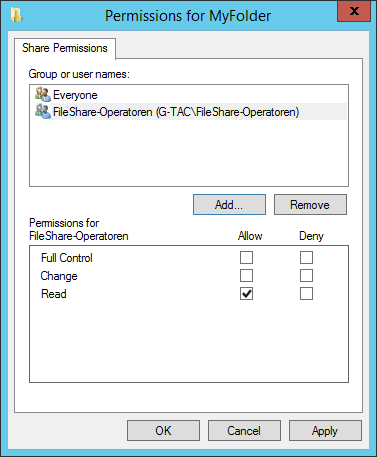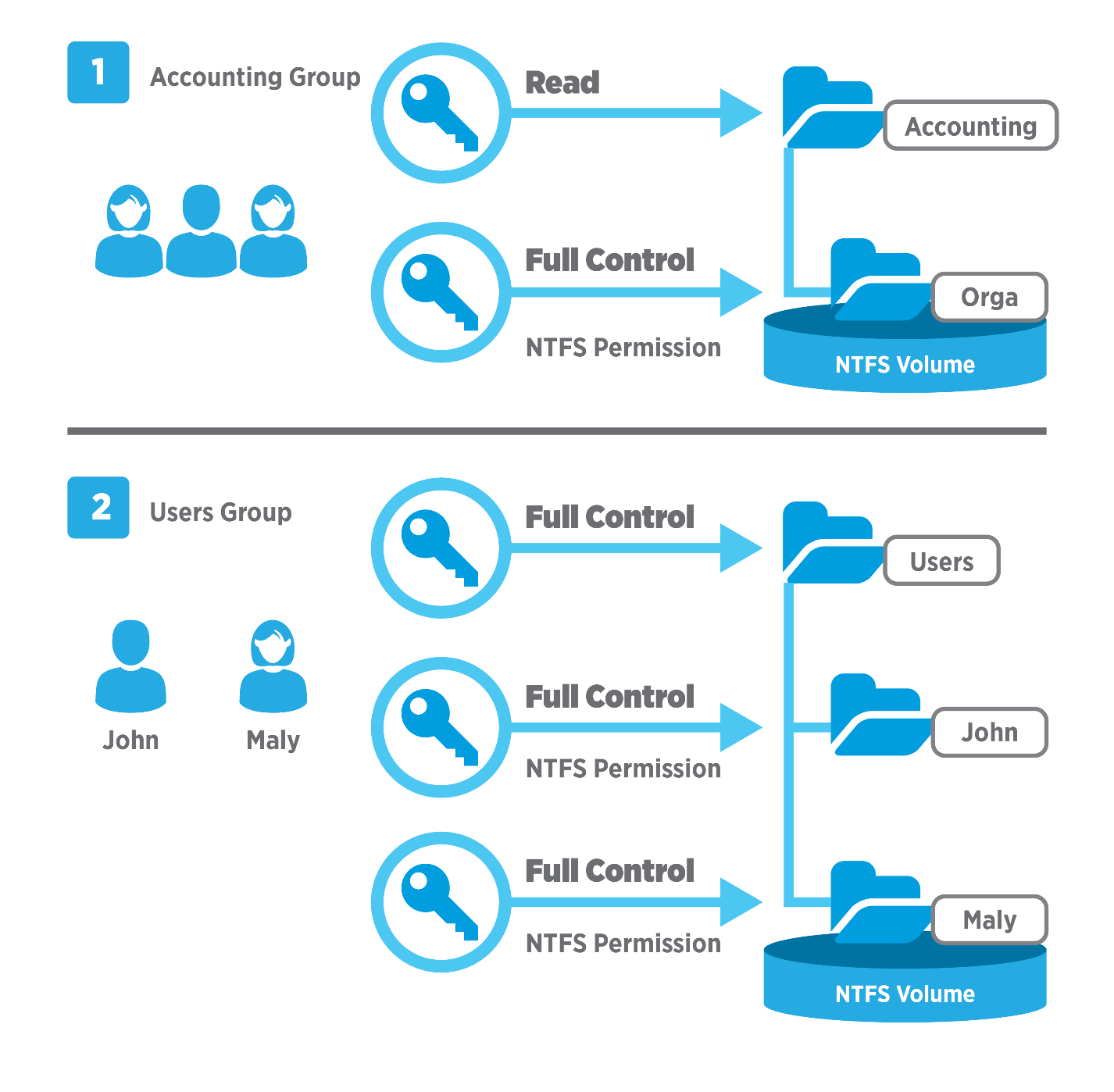Thủ Thuật về When we use both share and NTFS permission which one is applied? Chi Tiết
Pro đang tìm kiếm từ khóa When we use both share and NTFS permission which one is applied? được Cập Nhật vào lúc : 2022-10-29 21:35:05 . Với phương châm chia sẻ Bí kíp về trong nội dung bài viết một cách Chi Tiết Mới Nhất. Nếu sau khi Read nội dung bài viết vẫn ko hiểu thì hoàn toàn có thể lại phản hồi ở cuối bài để Ad lý giải và hướng dẫn lại nha.Symptoms
Article Summary: This article discusses NTFS permissions and share permissions in Windows and how they work together to regulate access to files and folders.
Nội dung chính Show- Difference between NTFS Permissions and Share Permissions
- Combining NTFS Permissions and Share Permissions
- 3 Examples of Combining Share Permissions with Folder Permissions
- Best Practices For Working With Permissions
- What happens when share and NTFS permissions combined?
- Can you mix NTFS permissions and share permissions on the same system?
- How do share permissions relate to NTFS permissions?
- When NTFS and share permissions exist on a thư mục the most restrictive permissions apply?
Windows provides two sets of permissions to restrict access to files and folders: NTFS permissions and share permissions.
- NTFS permissions are applied to every file and thư mục stored on a volume formatted with the NTFS file system. By default, permissions are
inherited from a root thư mục to the files and subfolders beneath it, though this inheritance can be disabled. NTFS permissions take effect regardless of whether a file or thư mục is accessed locally or remotely. NTFS permissions, the basic level, offer access levels of Read, Read and Execute, Write, Modify, List Folder Contents, and Full Control, as shown below:

There is also an advanced set of NTFS permissions, which divides the basic access levels into more granular settings. These advanced permissions vary depending on the type of object to which they are applied. The advanced permissions on a thư mục are shown below:

- Share permissions are only applied to shared folders. They take effect when a shared thư mục is accessed across a network from a remote machine. The share permissions on a particular shared thư mục apply to that thư mục and its contents. Share permissions are less granular than NTFS permissions, offering access levels of Read, Change, and Full
Control:

The most important thing to remember about NTFS permissions and share permissions is the manner in which they combine to regulate access.
The rules for determining a user's level of access to a particular file are as follows:
- If the file is accessed locally, only the NTFS permissions are used to determine the user's level of access.
- If the file is accessed through a share, NTFS and share permissions are both used, and the most restrictive permission applies. For example, if the share permissions on the shared thư mục grant the user Read access and the NTFS permissions grant the user Modify access, the user's effective permission level is Read when accessing the share remotely and Modify when accessing the thư mục locally.
- A user's individual permissions combine additively with the permissions of the groups that the user is a thành viên of. If a user has Read access to a file, but the user is a thành viên of a group that has Modify access to the same file, the user's effective permission level is Modify.
- Permissions assigned directly to a particular file or thư mục (explicit permissions) take precedence over permissions inherited from a parent thư mục (inherited permissions).
- Explicit Deny permissions take precedence over explicit Allow permissions, but because of the previous rule, explicit Allow permissions take precedence over inherited Deny permissions.
What is the difference between NTFS permissions and Share Permissions?
How do they work together?
Read more on how to use them correctly!
Difference between NTFS Permissions and Share Permissions
Share permissions are applied when a shared thư mục is accessed over a network.
When you log into a local Windows machine (even if a file or thư mục is shared to other users within your network), and you access an object locally, NTFS permissions apply and share permissions do not apply.
In other words, NTFS permissions are applied to users who are logged into the network locally while share permissions are not applied.
It does not matter how restrictive share permissions have been set up on your network, if you have access to the object and you are logged into the workstation or server that “owns” the file or thư mục, you will be granted access.
Combining NTFS Permissions and Share Permissions
When using share permissions and thư mục permissions, please keep in mind, you can apply different NTFS permissions to each thư mục within a shared thư mục. Working this way will ensure a permission strategy for each kind of data located in an appropriate thư mục structure.
A frequently asked question when managing Windows Server environments is:
Once you combine share permissions with NTFS permissions, how do these two types of permissions work together?
The answer is rather simple and helps you to determine the most effective form of permission for a shared thư mục.
Both sets of permissions get applied, and the more restrictive of the two takes precedent.
To give you a better idea, take a look the example below.
You give “Full Control” NTFS permissions to the “FileShare-Operatoren” group for a thư mục called MyFolder, as seen in the image below:

Full Control Permissions granted for MyFolder
If you share MyFolder within the Windows Network to the “FileShare-Operatoren” group using “Read” permissions and a user that belongs to this group tries to access the thư mục from the network, that user will only have “Read” access and not “Full Control”.
However, if that user then goes to the workstation or server where MyFolder is allocated, he will be granted “Full Control” permissions.

Read Only Share Permissions granted for MyFolder
3 Examples of Combining Share Permissions with Folder Permissions
In the next two examples, we have shared folders on NTFS volumes. These shared folders contain subfolders that have also been assigned NTFS permissions.

Combined Share and NTFS Permissions
First example:
- Accounting thư mục is shared.
- The Accounting group has the shared thư mục “Read” permission for this thư mục and the NTFS “Full Control” permission for the Orga subfolder.
The effective permissions for any thành viên of the Accounting group for the subfolder called Orga is “Read”.
Second example:
- Users thư mục contains home folders for each user, here John and Maly.
- Both home folders contain data accessible only to the user for whom the thư mục is named.
- The Users thư mục has been shared and the Users group has “Full Control” permission for the Users thư mục.
- John and Maly have the NTFS “Full Control” permission for their home thư mục only and no NTFS permissions for other folders.
- Boths are members of the Users group.
The effective permissions for John and Maly for their own home thư mục is “Full Control”. But John has no access to Maly’s home thư mục and Maly has no access to John’s home thư mục.
Third example:
In this last example, the group Sales has these permissions, as seen in the image below:
- NTFS Permissions Full Control for shared thư mục Sales
- NTFS Permissions Read for File1
- NTFS Permissions Full Control for File 2
The effective permissions are:
- The members of this group are granted only Read access to File1 because it is the most restrictive permission.
- And they are granted Full Control to File2 because both permission assignments are the same level.

Effective NTFS Permissions
Best Practices For Working With Permissions
- It’s recommended to always share a thư mục by giving full access to a group made up of everyone, then control who can access that thư mục using NTFS permissions.
- Always try to share folders with groups instead of individuals, as this makes administration tasks far easier.
- To consolidate administration and group files into application, data, and home folders, you should centralize all home and public folders separately from your applications and operating system files. Doing so provides the following benefits: a) permissions may only be assigned to folders, not individual files and b) backing up will be less complex because you will not need to back up application files, as all home and public folders will be consolidated in one location.
- When you assign permissions for working with data or application folders, assign the “Read & Execute” permission to the Users group and Administrators group. This will prevent application files from being accidentally deleted or damaged by users or viruses.
- Always assign the most restrictive permissions that still allow users to perform required tasks. For example, if users only need to read information in a thư mục and should never delete or create files, assign the “Read” permission.
- Organize your resources so that folders with the same security requirements are located within one thư mục. For example, if users require “Read” permission for several application folders, store those folders within a single thư mục. This will allow you to share that larger thư mục instead of sharing each individual application thư mục.
- Use intuitive share names so that users can easily recognize and locate resources. For example, for the Application thư mục, use “Apps” as the share name. You should only use share names that can be used across all clients operating systems.
What happens when share and NTFS permissions combined?
If you use share permissions and NTFS permissions together, the most restrictive permission will take precedence over the other. For example, if NTFS share permissions are set to Full Control, but share permissions are set to “Read,” the user will only be able to read the file or look the items in the thư mục.Can you mix NTFS permissions and share permissions on the same system?
You can apply different NTFS permissions to each file and subfolder that a shared thư mục contains. In addition to shared thư mục permissions, users must have NTFS permissions for the files and subfolders that shared folders contain to gain access to those files and subfolders.How do share permissions relate to NTFS permissions?
For maintenance and security reasons, you should not apply permissions to individual users. This is the window you will be looking : While share permissions only allow the three options (Full access, Modify and Read), NTFS permissions allow you to set access a more granular level, both for individuals and groups.When NTFS and share permissions exist on a thư mục the most restrictive permissions apply?
If the user is accessing a shared thư mục over the network and has both shared thư mục and NTFS permissions applied to it, the [most or least] restrictive permission is the effective permission. If the user is accessing a shared thư mục on the computer where it exists, shared thư mục permissions [do or do not] apply. Tải thêm tài liệu liên quan đến nội dung bài viết When we use both share and NTFS permission which one is applied? What is NTFS Advanced permissions windows Set security thư mục Datadvantage Reply
Reply
 8
8
 0
0
 Chia sẻ
Chia sẻ
Chia Sẻ Link Down When we use both share and NTFS permission which one is applied? miễn phí
Bạn vừa tìm hiểu thêm tài liệu Với Một số hướng dẫn một cách rõ ràng hơn về Video When we use both share and NTFS permission which one is applied? tiên tiến và phát triển nhất và ShareLink Download When we use both share and NTFS permission which one is applied? Free.